





My family calls me a pack-rat, and I guess that is what I am. The reason for this obsession is, once I find a use for something; I see it as a raw material, not trash. I collect as much raw materials as possible and keep a check on the recycle bins, just like our midnight marauding skunk, to see what I have to work with before I start a project.
I just cannot throw away anything that can be used for something, despite its original manufactured purpose. I have bins to separate and store items for recycling (glass, newspapers, cardboard, plastics, and metals) until I can take them to our county recycle center. I have a couple of bins to hold my kitchen vegetable scraps for the garden compost pile. We compost our yard waste, mostly grass clippings and leaves (see The Numbers of Leaves), for rich soil amendment and mulch.
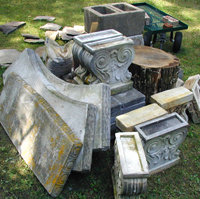 I have a large stack of culled bricks, concrete blocks, pads, and benches, and some terra cotta tiles. I also have stacks of wood in every possible area of the basement, shop building, and protected areas of the yard. I have boxes of broken floor tiles, dishes, and pots, along with pretty pebbles, marbles, and other thrift store and yard sale finds. My favorite raw material resources are the Goodwill Industries and Habitat for Humanity ReStores, and the home improvement center store's reduced price shelves.
I have a large stack of culled bricks, concrete blocks, pads, and benches, and some terra cotta tiles. I also have stacks of wood in every possible area of the basement, shop building, and protected areas of the yard. I have boxes of broken floor tiles, dishes, and pots, along with pretty pebbles, marbles, and other thrift store and yard sale finds. My favorite raw material resources are the Goodwill Industries and Habitat for Humanity ReStores, and the home improvement center store's reduced price shelves.
With the exception of some of the toad houses, the following projects were completed this summer from recycled items or materials leftover from other projects. Some materials had to be purchased to complete the projects. So it does cost a little money to repurpose some items, but we saved money on material costs on the overall projects, and the unique additions have made our lives more enjoyable and/or productive.
Place your mouse cursor over the pictures for more information!
I did not want to pick Kentucky Wonder pole beans, or my straw bale tomatoes, from a ladder any more than I wanted to spend the money for expensive trellis for them to climb on. We gathered enough concrete wire re-mesh to build a 7' wide x 6' tall x 24' long arched trellis and only had to buy a few fence posts to support the structure.
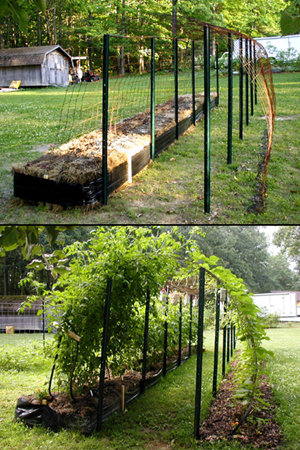 The arched trellis worked very well for us this summer, and now we will experiment with its potential as a green house this winter by covering it with clear plastic. We will keep the re-mesh as long as it supports the plants, then replace any rotting rusted sections with galvanized cattle panels which are nearly the same dimensions.
The arched trellis worked very well for us this summer, and now we will experiment with its potential as a green house this winter by covering it with clear plastic. We will keep the re-mesh as long as it supports the plants, then replace any rotting rusted sections with galvanized cattle panels which are nearly the same dimensions.
A friend offered us a 100-gallon pond liner and pump, so we used the bulk of our accumulated concrete, brick, and terracotta materials to build a little goldfish pond. We bought materials to extend electricity, pebbles for the walkway, and a few large rocks.
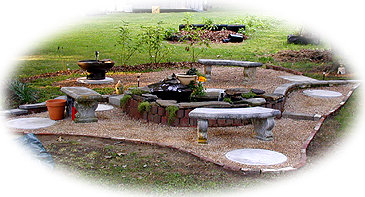
We made our berry trellises from discarded clothes line poles. The cross-members were cut, repositioned, and welded back onto the post. The posts were sanded, painted and hardware added to string the wires. Foam insulation was sprayed into the ends of the pipes to prevent bee nesting.
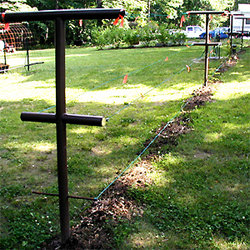
When my sons deconstructed an old mobile home for a friend, they salvaged enough scrap lumber and windows to use for a few building projects. We made a couple trellises, built a canned food storage room in the basement, and used a few of the 3-pane jalousie windows to make cold frame boxes to sit atop the raised beds in the garden. We will be using the rest of the scrap lumber to build and repair several more projects.
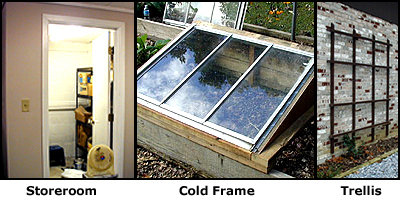
My husband works in the propane industry, so people call him when they want to get rid of old unused propane tanks. After properly depressurizing the tanks and cleaning them out, he makes yard rollers and heavy-duty burn barrels from the bottom portion of the big upright tanks. The discarded tank tops can be inverted, sanded, and painted, to create decorative water fountains, "bird showers" (for birds too busy to bathe), goldfish ponds, and fire pits.
Not everyone has the resources, tools, and skills to recycle such large and heavy materials, but this is an example how functional and beautiful items can be made from scraps.

I have a ridiculous number of rescued plastic jugs and bottles that I use for my winter-sowing containers. I can also use them to create little green houses to protect seedlings from the elements.
I can cut up the jugs to make scoops and funnels for manure, compost, sawdust, and other yard and garden materials.
I just learned that I can use the 2-liter bottles to propagate cuttings right on a shrub limb (still researching this method)!
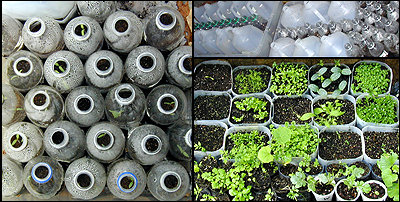 I use 2 and 3-liter soda bottles to make "Possum Pots." Here are a few slide show videos I created to show how to make them.
I use 2 and 3-liter soda bottles to make "Possum Pots." Here are a few slide show videos I created to show how to make them.
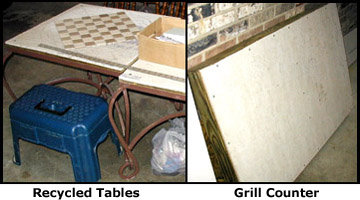
I make toad and fairy houses out of found and broken things that I glue onto clay flower pots, then cover with grout. I remove just enough grout to reveal the features I want shown. The leftover pot parts are used for fairy doors and broken pot saucers are made into toad pools.
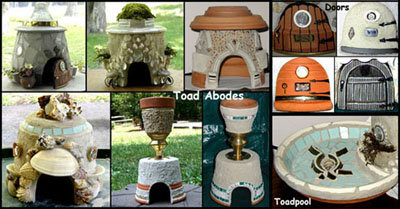
We depleted most of my raw material collections for these projects, but I have already started new piles for next year. Whether you judge me to be a pack-rat, or not, I love recycling and putting old things back into use, or repurposing. I would like to think that we have saved handling cost at our trash centers, as well as saving space in the land fills, for the items we recycled. And I believe our lives are much richer with all the treasures we’ve made for ourselves. Look around to see if you already have the raw materials needed to make those improvements for your yard and garden!
Oh yeah, about the skunk. I first met him very late one night while letting Ms. Peanut, my dog, out for a bathroom break. Mr. Skunk (gender not confirmed) was inspecting the recycle bins located by the back door. We quickly retreated inside and watched him from a slightly opened door. I hurriedly took the picture as he climbed out of the bin (it was a little blurry, so I enhanced it a little). I hear him in the bins at least once a week inspecting, rearranging, and repacking the raw materials. I think he learned his techniques from me! I guess that makes us both stinkin' pack-rats!
Visit Dave’s Garden Trash to Treasure forum for ideas and to share your recycling projects!
Copyright © www.100flowers.win Botanic Garden All Rights Reserved